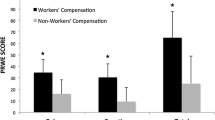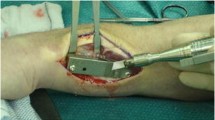Abstract
Background
Successful short-term results of diaphyseal ulna shortening osteotomy are documented in both idiopathic and post-traumatic ulnar impaction.
Questions/Purposes
The purpose of this study was to evaluate the mid-term outcomes of ulnar shortening osteotomy with respect to radiographic assessment of corrected alignment and healing as well as patient satisfaction, pain, and function assessed using the Disability of the Arm, Shoulder, and Hand (DASH) score.
Patients and Methods
This retrospective case series included follow-up of 33 patients with ulnar impaction syndrome following ulna shortening osteotomy at a minimum of 5 years. Patient-rated outcomes included satisfaction, pain assessment, and DASH score. Pre- and postoperative radiographs were reviewed to quantify ulnar variance and osteotomy union rates. Subsequent operations were also recorded.
Results
Average follow-up was 10 years (range, 5–20 years). Eighty-eight percent of patients reported they were either satisfied or very satisfied with the procedure and 91% reported they would have the same procedure again. Average pain rating was 2 out of 10 at final follow-up. The mean DASH score was 11 (range, 0–39). Removal of hardware was performed in 10 patients (30%). The overall rate of reoperation was 45%.
Conclusions
Ulna shortening osteotomy yields reliable midterm satisfaction and pain relief in patients with idiopathic and post-traumatic ulnar impaction syndrome. Reoperation is frequent. Consistent with results of short-term follow-up, plate irritation requiring removal remains the most common cause for reoperation over time.

Similar content being viewed by others
REFERENCES
Baek GH, Chung MS, Lee YH, Gong HS, Lee S, Kimg HH. Ulnar shortening osteotomy in idiopathic ulnar impaction syndrome. J Bone Joint Surg Am. 2005; 87A: 2649-2654.
Bernstein MA, Nagle DJ, Martinez A, Stogin JM Jr, Wiedrich TA. A comparison of combined arthroscopic triangular fibrocartilage complex debridement and arthroscopic wafer distal ulna resection versus arthroscopic triangular fibrocartilage complex debridement and ulnar shortening osteotomy for ulnocarpal abutment syndrome. Arthroscopy. 2004; 20: 392-401.
Chen NC, Wolfe SW. Ulna shortening osteotomy using a compression device. J Hand Surg. 2003; 28: 88-93.
Chun S, Palmer AK. The ulnar impaction syndrome: follow-up of ulnar shortening osteotomy. J Hand Surg. 1993; 18A: 46-53.
Constantine KJ, Tomaino MM, Herndon JH, Sotereanos DG. Comparison of ulnar shortening osteotomy and the wafer resection procedure as treatment for ulnar impaction syndrome. J Hand Surg. 2000; 25A: 55-60.
Fricker R, Pfeiffer KM, Troeger H. Ulnar shortening osteotomy in posttraumatic ulnar impaction syndrome. Arch Orthop Trauma Surg. 1996; 115: 158-161.
Goldfarb CA, Strauss NL, Wall LB, Calfee RP. Defining ulnar variance in the adolescent wrist: measurement technique and interobserver reliability. J Hand Surg. 2011; 36: 272-277.
Hunsaker FG, Cioffi DA, Amadio PC, Wright JG, Caughlin B. The American academy of orthopaedic surgeons outcomes instruments. Normative values from the general population. J Bone Joint Surg Am. 2002; 84: 208-214.
Loh YC, Abbeele VD, Stanley JK, Trail IA. The results of ulnar shortening for ulnar impaction syndrome. J Hand Surg (Br). 1999; 24B: 316-320.
Milch H. Cuff resection of the ulna for malunited Colles' fracture. J Bone Joint Surg Am. 1941; 23: 311-313.
Miura T, Firoozbakhsh K, Cheema T, Moeim MS, Edmunds M, Meltzer S. Dynamic effects of joint-leveling procedure on pressure at the distal radioulnar joint. J Hand Surg. 2005; 30A: 711-718.
Moermans A, Degreef I, DeSmet L. Ulnar shortening osteotomy for ulnar ideopathic impaction syndrome. Scand J Plast Reconstr Surg Hand Surg. 2007; 41: 310-314.
Nishiwaki M, Nakamura T, Nagura T, Toyama Y, Ikegami H. Ulnar-shortening effect on distal radioulnar joint pressure: a biomechanical study. J Hand Surg. 2008; 33A: 198-205.
Rayhack JM, Gasser SI, Latta LL, Ouellette EA, Milne EL. Precision oblique osteotomy for shortening of the ulna. J Hand Surg. 1993; 18: 908-918.
Sachar K. Ulnar-sided wrist pain: evaluation and treatment of triangular fibrocartilage complex tears, ulnocarpal impaction syndrome, and lunotriquetral ligament tears. J Hand Surg. 2008; 33: 1669-1679.
Sammer DM, Rizzo M. Ulnar impaction. Hand Clin. 2010; 26: 549-557.
Steyers CM, Blair WF. Measuring ulnar variance: a comparison of techniques. J Hand Surg. 1989; 14: 607-612.
Sunil TM, Wolff TW, Scheker LR, McCabe SJ, Gupta A. A comparative study of ulnar-shortening osteotomy by the freehand technique versus the Rayhack technique. J Hand Surg. 2006; 31: 252-257.
Disclosures
Conflict of Interest:
Duretti T. Fufa, MD, Ryan P. Calfee, MD, Nandita Sriram, BS, Andrew J. Weiland, MD have declared that they have no conflict of interest. Richard H. Gelberman, MD is a board member of JBJS Board of Trustees and Healthpoint Capital and receives royalties from Wolters-Kluwer and Medartis, outside the work. Michele G. Carlson, MD is a board member of ASSH, received a RJOS Research Grant, payments for manuscript preparation from Hand Clinics Editor 2012, patent pending on a retractor, and payments for travel expenses for meetings from HSS and ASSH, outside the work.
Human/Animal Rights:
All procedures followed were in accordance with the ethical standards of the Responsible Committee on Human Experimentation (institutional and national) and with the Helsinki Declaration of 1975 as revised in 2008 (5).
Informed Consent:
Informed consent was obtained from all patients for being included in the study.
Required Author Forms
Disclosure forms provided by the authors are available with the online version of this article.
Author information
Authors and Affiliations
Corresponding author
Additional information
Level of Evidence: Therapeutic Level IV, case series.
Rights and permissions
About this article
Cite this article
Fufa, D.T., Carlson, M.G., Calfee, R.P. et al. Mid-Term Results Following Ulna Shortening Osteotomy. HSS Jrnl 10, 13–17 (2014). https://doi.org/10.1007/s11420-013-9371-7
Received:
Accepted:
Published:
Issue Date:
DOI: https://doi.org/10.1007/s11420-013-9371-7




